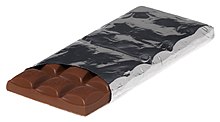Candy bar

A candy bar is a type of candy that is in the shape of a bar. The most common type of candy bar is the chocolate bar,[citation needed] including both bars made of solid chocolate and combination candy bars, which are candy bars that combine chocolate with other ingredients, such as nuts, caramel, nougat, or wafers.
Many varieties of candy bars exist,[1][2] and many are mass-produced.[3][4] Between World War I and the middle of the 20th century, approximately 40,000 brands of candy bars were introduced.[1][5]
Chocolate bars[edit]


A chocolate bar is a bar-shaped piece of chocolate, which may also contain layerings or mixtures of other ingredients. A wide variety of chocolate bar brands are sold. A popular example is a Snickers bar, which consists of nougat mixed with caramel and peanuts.
The first chocolate tablets were produced in the early 19th century.[7][8] In 1830, Kohler started producing hazelnut chocolate.[9] In 1866, Fry's Chocolate Cream became the first mass-produced combination chocolate bar.[10] The Goo Goo Cluster was the first mass-produced combination bar in the United States, including marshmallow, nougat, caramel, and roasted peanuts.[6] In some varieties of English and food labeling standards, the term chocolate bar is reserved for bars of solid chocolate, with candy bar used for products with additional ingredients.
Non-chocolate bars[edit]




Candy bars containing no chocolate include:
- Abba-Zaba: taffy with a peanut butter center
- AirHeads: a taffy based candy that comes in multiple flavours
- Big Hunk: nougat center covered with peanuts
- Bit-O-Honey: honey-flavored taffy with almond bits
- Cajeta Elegancita: caramel center covered with goat's milk
- Carambar: caramel-based candy
- Caramac: caramel-based candy
- Chick-O-Stick: peanut butter center covered with coconut
- Choo Choo Bar: liquorice-based candy
- Hershey's Cookies 'n' Mint: mint-flavored Hershey candy bar with mint-flavored cookie bits
- Hershey's Gold: caramel-flavored Hershey candy bar with peanuts and pretzels
- Kendal Mint Cake: peppermint-based candy
- Laffy Taffy: a taffy based candy that comes in multiple flavours
- Mantecol: a peanut butter nougat bar
- Mr. Tom: peanuts and caramel
- Munch: peanut brittle-like candy
- PayDay: peanuts and caramel
- Pecan log roll: cherry-laced nougat center covered with caramel and pecans
- Planters Peanut Bar: peanut brittle-like candy
- Salted Nut Roll: nougat center covered with caramel and peanuts
- Turkish Taffy: taffy-based candy
- Wazoo: taffy center covered with sprinkles
- Yeot-gangjeong: hangwa center covered in toasted seeds, nuts, beans or puffed grains mixed with mullyeot (rice syrup)
- Zagnut: peanut brittle wrapped in toasted coconut
See also[edit]
References[edit]
- ^ a b Norris, Susie; Heeger, Susan (2013-03-19). Hand-Crafted Candy Bars: From-Scratch, All-Natural, Gloriously Grown-Up Confections. Chronicle Books. p. 13. ISBN 978-1-4521-0965-7.
- ^ Insel, Paul; Ross, Don; McMahon, Kimberley; Bernstein, Melissa (2010-04-07). Paul Insel, Don Ross, Kimberley McMahon, Melissa Bernstein. Jones & Bartlett Publishers. ISBN 978-0-7637-9376-0.
- ^ Kiplinger's Personal Finance. Kiplinger Washington Editors. December 1947. p. 20.
- ^ Aaseng, Nathan (2005-05-31). Business Builders In Sweets and Treats. The Oliver Press. p. 28. ISBN 978-1-881508-84-7.
- ^ Insel, Paul; Ross, Don; McMahon, Kimberley; Bernstein, Melissa (2010-04-07). Nutrition. Jones & Bartlett Publishers. ISBN 9780763793760.
- ^ a b Kawash, Samira (2013). Candy: A Century of Panic and Pleasure. Faber and Faber. pp. 152–153, 156–157, 163. ISBN 9780374711108.
- ^ Barel, Michel (2021). Du cacao au chocolat: L'épopée d'une gourmandise. Éditions Quæ. p. 102. ISBN 9782759233793.
Le premier est François-Louis Cailler, l'inventeur de la tablette de chocolat telle que nous la connaissons aujourd'hui.
[The first is François-Louis Cailler, the inventor of the chocolate tablet as we know it today.] - ^ Petit, Élisabeth (29 December 2014). "Menier, une dynastie pour le chocolat". Ouest-France. Archived from the original on 22 May 2022. Retrieved 22 May 2022.
Les premières formes de tablettes, enveloppées de papier blanc, voient le jour. En 1836, Menier lance une tablette à six divisions semi-cylindriques. Le succès est au rendez-vous.
[The first chocolate tablets, wrapped in white paper, are created. In 1836, Menier launched a tablet with six semi-cylindrical divisions. Success is on the way.] - ^ Hermé, Pierre (2019). Le Larousse du chocolat. Editions Larousse. p. 44. ISBN 9782035981820.
Les noisettes furent les premiers fruits à être ajoutés dans le chocolat solide, une innovation suisse due à Kohler en 1830.
[Hazelnuts were the first fruits to be added to solid chocolate, a Swiss innovation due to Kohler in 1830.] - ^ Mintz, Sidney (2015). The Oxford Companion to Sugar and Sweets. Oxford University Press. p. 157.
Further reading[edit]
- Cadbury, Deborah, Chocolate Wars: The 150-Year Rivalry Between the World's Greatest Chocolate Makers (PublicAffairs, 2011)
- Mazze, Edward M. and Michman, Ronald D., The Food Industry Wars: Marketing Triumphs and Blunders (Praeger, 1998)
External links[edit]
 Media related to Candy bars at Wikimedia Commons
Media related to Candy bars at Wikimedia Commons
